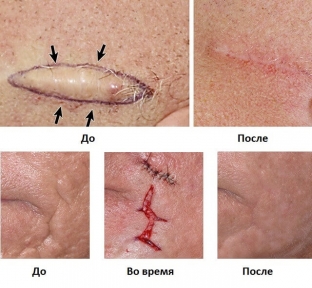Tissue scarring is a natural phenomenon that accompanies the wound healing process. The scarring phase begins approximately from the 15th day after the formation of the wound and is characterized by the gradual closure of the defect by the epithelium, the maturation of the connective tissue and the formation of a scar. Scars or scars are far from always a “decoration”, especially if they are located on visible areas of the body. In most cases, the scar can be removed with the help of low-traumatic methods such as dermabrasion or laser therapy. Surgical treatment of scars is often resorted to in cases where other methods are not effective enough. Estet-portal.com offers you a quick guide to the surgical removal of scars.
Surgical treatment of scars will help get rid of scars
Scars on the skin are formed in almost any violation of its integrity, whether it is an accidental injury or surgery.
If tissue damage is superficial, that is, only the epidermis is damaged, the wound can heal on its own, fairly quickly and without leaving scars, but if deep layers of the skin are affected, a permanent pronounced scar is formed that will never completely disappear.
In such cases, plastic surgery helps to get rid of the scar or reduce its severity, and the result of such operations directly depends on the skills of the doctor. What is important for a specialist to know about the surgical treatment of scars - read on.
Surgical treatment of scars:
• choice of tactics for surgical treatment of scars;
• general principles of surgical treatment of scars.
Choosing tactics for surgical treatment of scars
The main thing that is important for both the specialist and the patient to understand about the surgical treatment of scars is that complete restoration of the skin, as before damage, is impossible. The main task of the surgeon is to prevent the appearance of a cosmetically unsuccessful scar. The choice of surgical technique depends on the main characteristics of the scar: its size, color, density, position, direction, and age. It is important to consider that too early surgical removal of the scar can only worsen wound healing and lead to the appearance of even more pronounced hypertrophic scars. The patient's actions are that at least a week before the operation, he must stop taking aspirin, NSAIDs and anticoagulants, as well as exclude alcohol and nutritional supplements with vitamins C and E.

General principles of surgical treatment of scars
There are some general rules or principles for the surgical treatment of scars that it is important for every operating surgeon to know and remember:
• Before starting the operation, it is necessary to draw the planned incisions on the patient's skin, while he must stand or sit; it is also important to mark anatomical landmarks that may not be visible during surgery;
• Fresh wounds that do not show signs of inflammation and have clean and even edges heal faster. This can be achieved by aligning the edges of the wound gently, without applying excessive tension, and using an inert suture material;
• Support sutures that attach the protruding edge of the wound to the periosteum;
• after the operation, it is necessary to apply a pressure bandage for a day and warn the patient about the need to avoid injury and tension in the scar area.<
If necessary, dermabrasion or laser therapy can be performed 6-8 weeks after the surgical treatment of scars, which will help improve the result of the operation.Surgical treatment can remove large, disfiguring scars on the patient's face and body, thereby significantly improving his quality of life.






Add a comment